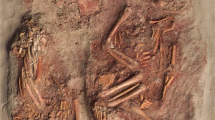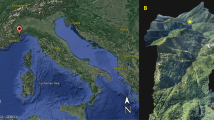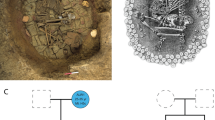Abstract
Decorations on the bodies of newborns indicate that they were probably important in their community.
Several adult graves from the Stone Age (Upper Palaeolithic period) have been found but child burials seem to be rare, which has prompted discussion about whether this apparently different treatment of infants could be significant1,2. Here we describe two recently discovered infant burials from this period at Krems-Wachtberg in Lower Austria, in which the bodies were covered with red ochre and decorated with ornaments and were therefore probably ritually buried. These findings indicate that even newborns were considered to be full members of these hunter−gatherer communities about 27,000 years ago.
This is a preview of subscription content, access via your institution
Access options
Subscribe to this journal
Receive 51 print issues and online access
199,00 € per year
only 3,90 € per issue
Buy this article
- Purchase on SpringerLink
- Instant access to full article PDF
Prices may be subject to local taxes which are calculated during checkout

Similar content being viewed by others
References
Trinkaus, E. & Svoboda, J. Early Modern Human Evolution in Central Europe. The People of Dolní Věstonice and Pavlov (Oxford Univ. Press, 2006).
Zilhão, J. & Trinkaus, E. Portrait of the Artist as a Child (Trabalhos de Arqueologia 22) (Instituto Português de Arqueologia, Lisboa, 2002).
Neugebauer-Maresch, C. Preistoria Alpina 39, 165–173 (2003).
Einwögerer, T. Die Jungpaläolithische Station auf dem Wachtberg bei Krems, NÖ (Mitt. Prähist. Komm. Österr. Akad. Wiss. 34) (Akademie der Wissenschaften, Wien, 2000).
Svoboda, J., Neugebauer-Maresch, C., Králík, M., Einwögerer, T. & Novotný, V. Přehled Výzkumů 45, 256–259 (2004).
Svoboda, J. Přehled Výzkumů 46, 63–82 (2004).
Teschler-Nicola, M. & Trinkaus, E. J. Hum. Evol. 40, 451–465 (2001).
Author information
Authors and Affiliations
Corresponding author
Ethics declarations
Competing interests
The authors declare no competing financial interests.
Supplementary information
Supplementary Figure 1
Krems-Wachtberg 2005: View into the excavation pit from the east. (PDF 196 kb)
Supplementary Figure 2
Krems-Wachtberg 2005-2006: Plot of the North Profile generated from the database with horizons and collected samples. (PDF 123 kb)
Supplementary Figure 3
Krems-Wachtberg 2005-2006: Surface models showing two subsequent phases of the main find layer and the features Pit 3, (Double-) Burial 1 and Burial 2. (PDF 166 kb)
Supplementary Figure 4
Krems-Wachtberg 2006: Detail of the West Profile showing Pit 3 as well as the main cultural layer AH 4 and archaeological horizon AH 5. Above Pit 3 several debris layers are visible. (PDF 158 kb)
Rights and permissions
About this article
Cite this article
Einwögerer, T., Friesinger, H., Händel, M. et al. Upper Palaeolithic infant burials. Nature 444, 285 (2006). https://doi.org/10.1038/444285a
Received:
Accepted:
Published:
Issue Date:
DOI: https://doi.org/10.1038/444285a
This article is cited by
-
Anatomically modern human in the Châtelperronian hominin collection from the Grotte du Renne (Arcy-sur-Cure, Northeast France)
Scientific Reports (2023)
-
Miniaturization and Abstraction in the Later Stone Age
Biological Theory (2023)
-
The Ornaments of the Arma Veirana Early Mesolithic Infant Burial
Journal of Archaeological Method and Theory (2023)
-
An infant burial from Arma Veirana in northwestern Italy provides insights into funerary practices and female personhood in early Mesolithic Europe
Scientific Reports (2021)
-
Tracing human mobility in central Europe during the Upper Paleolithic using sub-seasonally resolved Sr isotope records in ornaments
Scientific Reports (2020)



